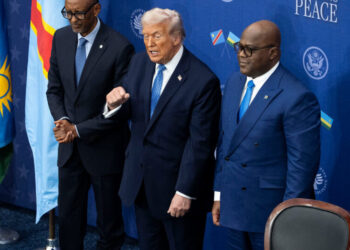
Ron Wahid is CEO of Magellan Investment Holdings and Chairman of the strategic intelligence firm Arcanum.
I recently returned from the embattled city of Pokrovsk, where Ukrainian forces continue to hold the line against overwhelming odds. Their resilience is due to the extraordinary work of the country’s intelligence and special forces, which have continued to pull off surprisingly effective asymmetriccal strikes deep behind the front lines. After speaking directly with Gen. Oleksandr Syrsky, commander in chief of the Ukrainian armed forces, I felt assured that Pokrovsk, should it eventually fall, will have cost Russia dearly — and that Russia will continue to bleed profusely while advancing across every additional meter of Ukrainian land.
Ron Wahid is CEO of Magellan Investment Holdings and Chairman of the strategic intelligence firm Arcanum.
I recently returned from the embattled city of Pokrovsk, where Ukrainian forces continue to hold the line against overwhelming odds. Their resilience is due to the extraordinary work of the country’s intelligence and special forces, which have continued to pull off surprisingly effective asymmetriccal strikes deep behind the front lines. After speaking directly with Gen. Oleksandr Syrsky, commander in chief of the Ukrainian armed forces, I felt assured that Pokrovsk, should it eventually fall, will have cost Russia dearly — and that Russia will continue to bleed profusely while advancing across every additional meter of Ukrainian land.
But despite the remarkable heroism of Ukraine’s fighters, the war’s outcome remains uncertain. And American support remains vital. President Donald Trump’s recent decision to withhold Tomahawk cruise missiles reflects strategic caution, and was the right call. The United States should continue to help Ukraine defend itself, but providing Tomahawks that are difficult to field and integrate makes no sense. Instead, the focus should be on delivering weapons that are immediately deployable, alongside ramped up economic pressure, to push Moscow to agree to a negotiated end to the hostilities without getting trapped in an escalatory spiral.
Ukraine is proving itself to be exceptionally adaptive. Domestically produced long-range drones have struck deep inside Russia. The daring “Operation Spider Web,” in which Ukraine’s spy services unleashed a swarm of drones smuggled in on trucks, disabled an estimated 34 percent of Russia’s bomber strike force while they were still on the ground. And sea drone operations have rendered the Black Sea fleet impotent. The U.S. should help amplify these emerging strengths. Cooperating on innovations in this sector not only helps Ukraine in its fight today, but also teaches lessons that shape how the U.S. military will confront adversaries in the future.
Ukraine urgently needs more tools that can stop Russian advances on land and disrupt aerial attacks at their source. Fortunately, there are viable systems compatible with Ukraine’s existing platforms. The Extended Range Attack Munition (ERAM) missile, which is compatible with Ukraine’s F-16s, offers a strike range of approximately 280 miles. Germany’s Taurus cruise missiles also reach over 300 miles and are designed to penetrate heavily fortified targets. These weapons would give Ukraine the ability to hit advancing Russian forces, logistics hubs, supply lines and command centers, directly disrupting Russia’s ability to sustain offensive operations.
Recent sanctions on Russia’s largest oil companies were a welcome first step that should be built upon. The Trump administration’s move to block the Swiss commodity trader Gunvor from acquiring the assets of Russian oil company Lukoil, as well as Bulgaria’s decision to seize a Russian-owned refinery, have sent shock waves through Moscow’s energy industry. The logical next step is implementing secondary sanctions that would discourage foreign entities from purchasing Russian oil.
The danger of piling on pressure is that it tempts both sides to escalate further. Ukraine should therefore pursue a strategy that secures sovereignty while always providing Russia a credible exit option. For example, as a start of negotiations, Ukraine could offer a devolved governance structure for the occupied Donbas region, modeled on the Good Friday Agreement. Under such a plan, Donbas would remain within Ukraine but with significant local autonomy, guaranteed language protections and administration supported by multinational peacekeeping forces. This would prevent the region from becoming a frozen conflict while restoring territorial integrity.
Regardless of the final outcome of talks, accepting any territorial compromise must be paired with securing Ukraine’s long-term future with deeper security and economic integration with Western partners. American involvement in any such arrangement is a must. And to lock in the United States, especially as an economic partner, Ukraine must reform. Favoritism and opaque regulations routinely frustrate U.S. firms, making doing business an exercise in endurance rather than opportunity. While fighting corruption is a generational project, abolishing various administrative hurdles is comparatively a low-hanging fruit. Additionally, granting the United States with “most favored nation” status would help transform the relationship into a true partnership.
Ukraine does not need every advanced system imaginable; it needs support that is strategically decisive. The right mix of calculated military aid, targeted sanctions and coordinated diplomacy can secure Ukraine’s position without triggering uncontrolled escalation.
The post The U.S. can help Ukraine beat Russia without escalating the war
appeared first on Washington Post.




